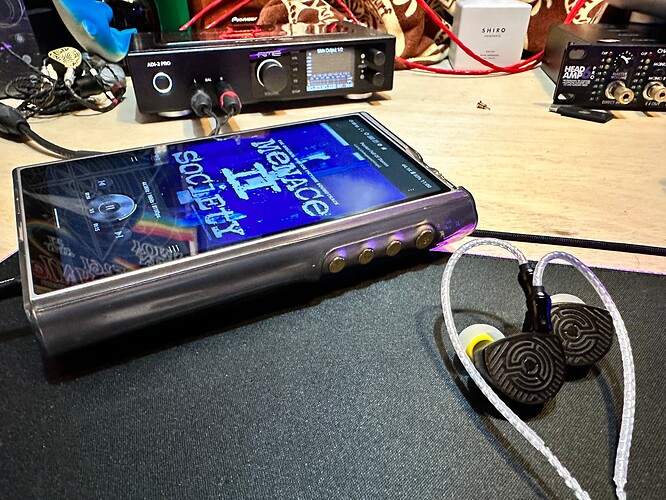I was thinking of a similar analogy of being at a concert and a buncha peavy stacks at low gain /volume v.s. a few sets of home floor speakers at same measured output.
You’d be able to tell which is which even if they were at same SPL/ ludness where you were standing.
The brain and body are amazing machines
I agree with you, our perception of sound changes every day, from mood, atmospheric pressure, weather, etc…
Can you stop spamming in here and delete all that?
Thanks
I am just wondering if you have any idea on where this perceived change may come from on a technical level?
Especially talking about IEMs where there are nowhere near as much of a body (non eardrum) related transfer apart from skin and hair in the ear canal as there are in speakers.
Asking since I myself never found clear correlation between driver size and the way shit sounds in IEM ![]()
I’m not quite sure what you mean, but I’ll try.
You mean how I heard the difference between a 7mm and 14mm driver in my ear?
No, assuming you have 2 same FR graphing IEMs made of same materials 1# 7mm/2# 14mm and you listen at the same volume (not amp setting, but the real measured SPL) - what is causing the difference in perception?
Not being ironic, just curious if there is technical explanation ![]()
Words can’t explain it in any way)
Unless you try to draw it ![]()
I have a 14.5 in my ear right now, if it were a 7 or 6mm in same shell touching same area of my ear and both were resin the bigger driver would seem to vibrate more because more surface area (not the diaphragm) though that helps since it is the amount of that driver that is touching the inside of the shell so more area is transferring sound.
This is the same analogy of sitting infront of a stage with big stacks outputting 126dB v.s. many fewer and smaller drivers in a collection of common tower house speakers…also measuring 126dB at your torso (ear level)
More area
more area moving
more consequential stimulation of everything sound waves touch.
I think you’d be able to tell if you were infront of a wall of amps and a few sets of home speakers
perception of height?
Width?
Several other things not directly related to exact SPL
I agree with the drivers at same spl and same performance, there’s one thing that’s different, it’s the fundamentals in subbass, infrasonics, and the leak tolerance of drivers.
This is just my own opinion, I’ve experimented with 38d1xj (bass ba), ed29689 (I’ve forced it through dampers to play bass, fed,
Ive messed around with DDs, 8mm, 10mm, 11.5.mm, 14.2mm, 15.3mm, 16.3mm
I’ve also messed with bone conductors as well, spring shrapnel type and fixed types. Haven’t messed with haptic ones till now.
So across all this, I’ve noticed the drivers hold up in bass through spl. What makes the difference however is the leak tolerance, which directly affects how low we can go into the infrasonics.
I’ve seen cases where people didn’t appreciate the bass on meteor just cuz fit issues. In the end, seal is a major factor. As for characteristics, dynamic drivers movement also changes how the bass feels in character to a BA, but overall, most drivers if not all can put up a good fight if implemented right. But if the iem design is such that there’s gonna be leaks beyond a driver’s capability, the bass will suffer. Larger drivers have better leak tolerance and in exchange, better infrasonics as well.
Ofc feel free to debate, this is just my observation so far
P. S bone conductors don’t do subs, you can hear them but that’s about it, you’ll need like 100mm drivers to go pretty low.
Trio is damn good as a midbass monster. 64 audio’s air buffer chamber so well designed they practically extracted every last ounce of performance out of that driver. Wish it was a bit towards the subbass tho, midbass plus overly bright, threw me off.
The last I heard a 64audio was the u4s. I loved that one.
My memory is a little shotty so I don’t quite remember them being overly bright, but I do remember them being my favorite out of the 12t, Fourte and Duo all listened to back to back and it came down to the bass. The Trio had the best bass, no doubt. The 12t was impressive for being all BA, very DD like, but as good as a really good DD. And the U4s was also very good, I agree. You can find 2nd hand models for around $700 now a days i feel that’s a great deal.
I found them bright despite almost tuning near same amount of Treble in some of my earlier attempts. I suppose it’s mostly the lack of subbass (rolls off for the midbass dominance) that contributes in making it feel bright, cos funnily the midbass isn’t particularly towards the warm kind…
This is why I wanted to skip comparisons to speakers systems as this comparison does not translate 1 to 1 to IEM imo.
I would rather say that better comparison would be to try to differentiate cranked up home speakers and concert hall wall of amp, but placed in a room and a listener listening to them behind the corridor leading to that room. As drivers are placed behind the nozzle being the bottleneck from the airflow perspective.
In headphones or even earbuds there is a direct transfer without acoustic channeling so much closer to speakers
You’re so far into the tuning side of IEMs that I respect your opinion for sure. I don’t mind bright IEMs with a bass boost, it just depends on where that brightness is. If it’s in the mid-treble like 5-6k it’s a no-go for me. But if it’s more in the air region of the tuning, even though unnatural, I really enjoy them for sure.
Thank you, that is very interesting and clever perspective from IEM maker ![]()
Ah you’re like me, i have a 2BA combo that can achieve that, right after ear gain is an immediate drop in spl from 4.5k -20k pretty much being an almost flat squig, that would be my standard preference with Ear gain peak being around 6db focused in 2-3k agressive raise.
Well…my kolega ME przyjaciel…do you remember Newton’s second law of motion…from school…which relates to acceleration of net force and mass… A = F/m…in this case the mass is the weight of the diaphragm…the weight has potential energy one might say, precisely because in that inertial frame the object’s relativistic kinetic energy is zero…but it has potential
and this potential is called the “relativistic mass,” as the product of the rest-mass of the object
like this…PE=mgh
energy is never created or lost…it is only transformed from one form to another… so as you apply energy…in this case…in the form of current…that is transformed into sound pressure through movement of the diaphragm
But a larger mass requires more energy to move at similar accelerations…so a smaller mass will have a quicker response time and subsequently sound faster to the person…that’s why BAs sound fast in transients…their start/stop curves are relative though and as you apply more force the acceleration will be correspondingly so
In layman’s terms…a smaller driver just cannot under any circumstances…move as much air as a larger one…it’s just physically impossible…but pressure…that’s a different story
If any one wants to really understand the theory…this gentleman… Peter S. Bernard…wrote a book about computational fluid dynamics…very interesting…even to a layman
Absolutely
I tried to explain how I perceive the difference in surround.
And as for the frequencies, I completely agree with the @BASS_0Range
Sub bass, this is the part that will not be able to transmit a 7mm driver qualitatively. Sorry for my English and understanding, I have to translate through a translator every time.((


